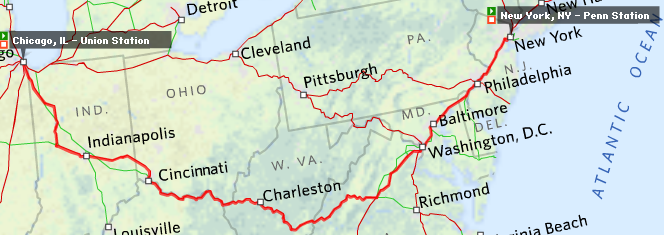A Little More Regulation, Maybe?
A couple of weeks ago, I mentioned that NARP—that’s the National Association of Railroad Passengers—is campaigning for Amtrak to increase the frequency of the Cardinal. The train now operates three days a week between New York and Chicago on a route that runs through Indiana, Kentucky, West Virginia and Virginia.

A major component to NARP’s effort is three professionally produced radio spots that are being distributed to radio stations strung out in communities along most of the Cardinal’s route. The spots are 30-seconds long and are “public service announcements”—known in the trade as PSAs. That means radio stations are expected to run them free of charge because, as the name implies, the message they contain is considered to be of benefit to the general populace.
From the early days of radio, broadcasters were required to “give back” to their communities in return for use of the public airways—the frequencies which carried their signals. That’s one reason why, for instance, radio stations had hourly newscasts, at least five minutes long. Many stations ran regular editorials, and that’s when the so-called “equal time” regulation kicked in, requiring them to give free air time to opposing views.
Well, those days are gone. They disappeared in 1981 when Congress did away with a lot of the regulations controlling radio and TV stations, including the “equal time” provision and the requirement that they air some public service programming. There is simply no doubt that those rulings have been a contributing factor to the dumbing down of the American public.
All of this relates to NARP’s efforts in advocating a daily Cardinal because our volunteers are reporting that more than a few radio stations simply said they would not air NARP’s public service announcements. I’m sorry, but that angers me. These stations—several feature exclusively “Christian” programming, by the way—apparently feel no sense of responsibly to the broader community.
Well, they damn well should. And if they won’t do it on their own, then I’m all for regulations requiring them to do it.



The public is much better served today when radio stations are freer to program what the public wants to hear, rather than what FCC bureaucrats thought should be programmed. And that includes letting each station develop their own policy regarding public service announcements.
Doubt if the listening public wants to go back to the days when the FCC would require EACH station, regardless of programming format, to carry ‘X’ amount of agricultural programming, religious programming, public affairs programming, and children’s programming.
This all started because, as you mentioned, the public ‘owned’ the airwaves and the concern was that airwave space was scarce and could not accommodate many different voices, or stations.
That’s certainly not the case today.
In Honolulu, for example, with terrestrial radio alone, the public can choose to listen from among 18 FM stations and 18 AM
stations. And do all 36 stations really need to do 5 minutes of news on the hour? What about listeners who want more music?
Regarding public service announcements each station, mainly based on their programming format, does have their own policy regarding free access to their signal. In the case of your volunteers being turned down, my guess is we don’t know the entire story.
I would find it interesting to look into that. (Which stations, their programming format, and their PSA policy.)
In 2016, this could be a reason some stations may be limiting PSA access: stations indeed are required to offer equal time to opposing political candidates and in this political year their spot inventory could be stretched to the limit because of that.
If candidate ‘A’ buys 30 ads a week, then candidate ‘B,’ and as many other candidates are running each have to be guaranteed the opportunity to run a similar schedule. So, during the political season there may indeed be fewer PSAs broadcast. Even commercial ads may be bumped if the political demand is high enough, otherwise listeners would just hear all ads all the time and no music or other programming. And, of course, listeners wouldn’t stand for that, they’d tune out. Taken an unfortunate step further,
if the Honolulu listener couldn’t what he/she wanted on any of the 36 radio stations, they would then turn to satelite radio, cable radio,or internet radio.
As far as the public ‘owning’ the airwaves, not until I spend hundreds of thousands of dollars on steel towers, expensive antennas and transmitters, audio equipment for the studio, and consulting services to make it all happen, there’s nothing of value there for the public to ‘own.’ (In this digital/internet/cable age when listeners have untold choices, the whole idea of public ‘ownership’ of the broadcasting airwaves probably needs to be revisited.)
Sorry, but I cannot agree that the public is better served post deregulation. Providing “what the public wants” is hardly a guarantee of quality programming. And absent any equal time requirement, we end up with a public that is massively–and deliberately–misinformed.